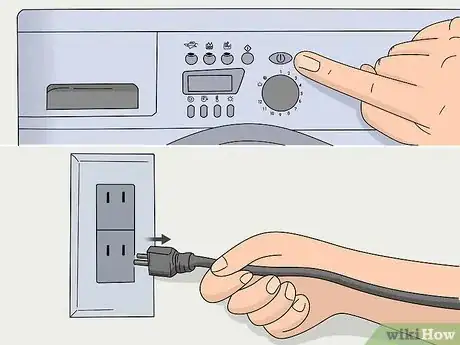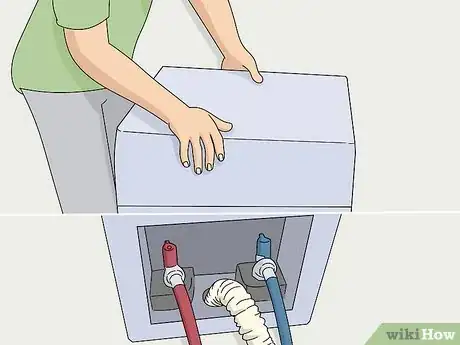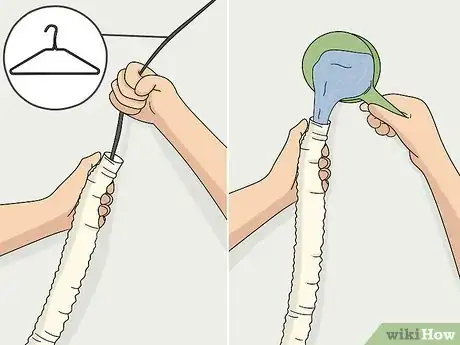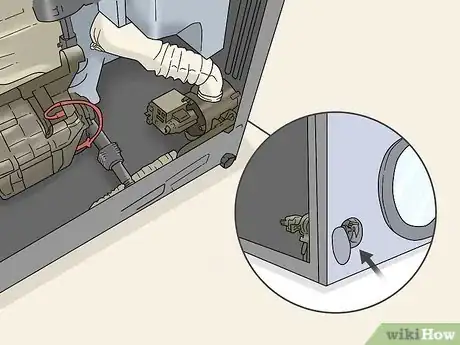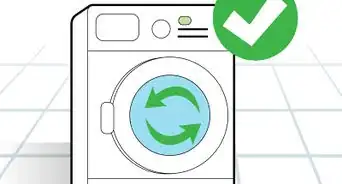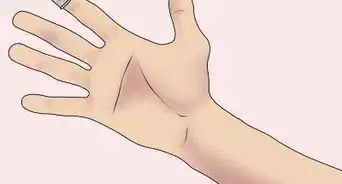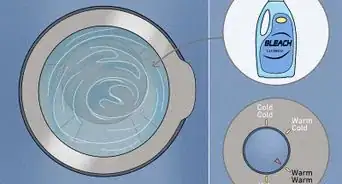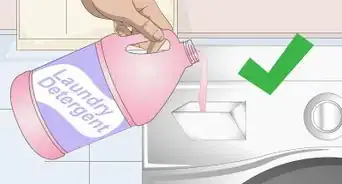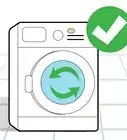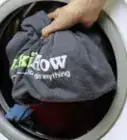This article was co-authored by Gevorg Grigorian. Gevorg Grigorian is an Appliance Repair Specialist and the Owner of G and R Appliance Repair in Los Angeles, California. With over 12 years of experience, Gevorg specializes in residential and commercial appliance repairs as well as heating, ventilation, and air conditioning (HVAC) services. Gevorg holds a BS in Business Administration and Management from California State University-Northridge.
This article has been viewed 38,672 times.
It is super frustrating to open your washing machine only to find that it is still full of water! This can happen for several reasons, but the most common one is a clog somewhere in the system. Before checking for the obstruction, turn off the washing machine and unplug it from its power source. Then check both the drain hose and the drain pump to see if something got lodged in either of them.
Steps
Cleaning out the Drain Hose
-
1Turn off the power and unplug the washing machine. If your washing machine has an “off" or “cancel” button, press it, especially if the washer was in the middle of a load when you realized it wasn’t draining. Then, unplug the washing machine from its power source.[1]
- The power must be turned off while you’re working on the washing machine so you don’t risk getting electrocuted.
Tip: Use duct tape to attach the power cord to the side of the washing machine so it doesn’t accidentally get wet or in the way while you’re working.
-
2Pull the washing machine out from the wall to access the drain hose. The drain hose is normally located on the back of the washing machine next to or in between the hoses for the hot and cold water. The drain hose is usually gray or black, while the water hoses are either red or blue.[2]
- A kink in the hose could be the cause of the clog. If you see one, untwist it, turn the washing machine back on, and run a spin cycle to see if the water drains away.
Advertisement -
3Set a towel or small pan beneath the drain pipe and drain hose. The drain pipe is where the hose enters the washing machine. The towel or pan will help catch any water that comes out when you detach the hose.[3]
- At this stage, don’t worry about draining the excess water from the inside of the washing machine. If the cause of the clog is in the drain hose, you should be able to clear the hose, hook it back up, turn on the machine, and run a spin cycle.
-
4Detach the drain hose from the back of the washing machine. Just wiggle the hose until it comes loose from the drain pipe. If the hose is stuck to the pipe, use WD-40 or something similar to loosen the connection.[4]
- The other end of the drain hose can remain in the washbasin or main drain where it usually empties the water.
-
5Feel along the length of the hose or try running water through it. You may be able to feel a blockage in the hose by gently squeezing it from one end to the other, or you can run water through one end to see if it exits the other side.[5]
- If the water runs through the length of the hose easily, chances are that it is not the source of your clog.
- Sometimes socks or other small clothing items can get lodged in the hose.
-
6Unclog the hose with a long-handled instrument. If the hose is indeed clogged, manually unclog it with something like the end of a wire coat hanger or a plumber’s snake. Push the long-handled instrument through one end of the hose and continue pushing until the blockage has been dislodged.[6]
- Try running water through the hose one more time to fully rinse it of any lingering debris or lint.
-
7Replace the drain hose and restart your washing machine to test it. Plug the drain hose back into the drain pipe, push the washing machine back into place, plug it in, and turn it on. Run a drain or rinse cycle to check if the water in the washing machine can now drain out through the hose.[7]
- If this solves your problem, that is great! If the machine still isn’t draining, the problem may lie with the drain pump or some piece of internal hardware.
Tip: After draining out the excess water from the washing machine, rewash the garments or clothes that were in the machine when it stopped working. Depending on how long the water was sitting in the washing machine, things could have started to develop mold or mildew.
Checking the Drain Pump
-
1Shut off the washing machine and unplug it from its power source. Not every washing machine has a power button, but turn yours off if it does. Unplug the cord from the power outlet so no electricity is running to the machine while you’re working.[8]
-
2Siphon the excess water into a 5 US gal (19 L) bucket. Pull the machine out from the wall to access the drain hose. Wiggle the drain hose off of the drain pipe, which is where it enters into the washing machine. Put the end you just disconnected into the bucket and drain out the water. Reconnect the hose to the pipe, let it fill with water, and then drain it again. Repeat this siphoning action until most of the water has been drained away.[9]
- If there were clothes or garments in the machine when it stopped working, remove them from the washer and squeeze out the excess water before setting them to the side in a laundry basket.
- You may need to tilt the washing machine onto its side while working on it in order to empty as much water as possible.
-
3Remove the washing machine panel to view the pump. The panel is either in the front or back of the washing machine. For older models, it may be underneath the machine; if it is, tilt the washing machine forward to get to it. You should be able to easily remove the panel with your hands. If you aren’t sure where the washing machine’s panel is, consult the owner’s manual.[10]
- The pump is what powers the washing machine and indicates whether it should be recirculating water or draining water out of the drain hose.
- If the pump gets clogged or stuck, the machine won’t be able to drain away excess water.
- This panel will likely be on the front of a front-loading washer.[11]
-
4Check the filter to see if it is clogged with fibers or buildup. Next to the pump, you should see a filter cap that covers the actual filter itself. Unscrew the cap and examine the filter for gunk or debris that could be clogging your machine. Rinse it off or use a damp cloth to wipe it down.[12]
-
5Test the impeller to make sure it can move freely and isn’t stuck. The impeller is a rotating hub that agitates the water in the washing machine. With the filter cap still removed, run your fingers along the inside of the impeller to see if it moves easily. If it doesn’t, there may be something small like a coin or small sock in the way. Remove any blockage you find; you could use tweezers or pliers to pull out small blockages.[13]
- Be careful that your fingers don’t get stuck or pinched in the impeller.
-
6Start a small load to see if the problem has been resolved. Replace the filter cap, close the washing machine panel, reposition the machine, and plug it back in. Try running a small load of just water to see if the machine will now drain.[14]
- If this doesn’t resolve the issue and you’ve already checked the drain hose, there most likely is a mechanical problem that needs to be addressed.
Warnings
- Always unplug your washing machine before working on it.⧼thumbs_response⧽
Things You’ll Need
Cleaning out the Drain Hose
- Duct tape (optional)
- Towel or small pan
- WD-40 (optional)
- Wire coat hanger or other long-handled instrument
Checking the Drain Pump
- 5 US gal (19 L) bucket
- Washcloth
- Rubber gloves (optional)
- Tweezers or pliers
References
- ↑ https://www.bobvila.com/articles/how-to-drain-a-washing-machine/
- ↑ https://www.bobvila.com/articles/how-to-drain-a-washing-machine/
- ↑ https://www.bobvila.com/articles/how-to-drain-a-washing-machine/
- ↑ https://www.bobvila.com/articles/how-to-drain-a-washing-machine/
- ↑ https://www.bobvila.com/articles/how-to-drain-a-washing-machine/
- ↑ https://www.trustedreviews.com/how-to/unblock-washing-machine-wont-drain-3676911
- ↑ https://www.trustedreviews.com/how-to/unblock-washing-machine-wont-drain-3676911
- ↑ https://www.bobvila.com/articles/how-to-drain-a-washing-machine/
- ↑ https://www.bobvila.com/articles/how-to-drain-a-washing-machine/
- ↑ https://www.bobvila.com/articles/how-to-drain-a-washing-machine/
- ↑ https://www.bobvila.com/articles/how-to-drain-a-washing-machine/
- ↑ https://www.trustedreviews.com/how-to/unblock-washing-machine-wont-drain-3676911
- ↑ https://www.trustedreviews.com/how-to/unblock-washing-machine-wont-drain-3676911
- ↑ https://www.trustedreviews.com/how-to/unblock-washing-machine-wont-drain-3676911
